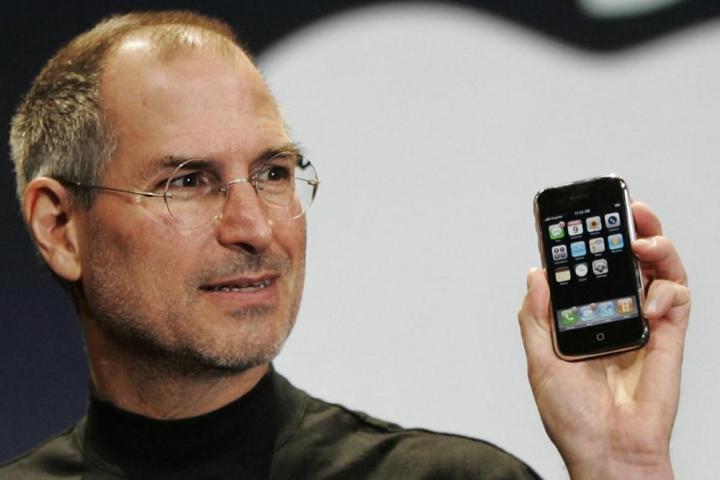
Fifty-nine years ago today, a baby boy was born to Abdulfattah Jandali and Joanne Scheible, an unmarried couple living in San Francisco, California.
That baby turned out to be Steve Jobs, a man we know today as a technological revolutionary who passed on way too soon.
In 1955, however, there was little to indicate he would become a colossus in Silicon Valley. He was put up for adoption because his birth mother’s family objected to Joanne’s relationship with Abdulfattah, and the Armenian couple that adopted him, Paul and Clara Jobs, was not particularly well-off or well-educated.
Mr. and Mrs. Jobs cared deeply about their adopted son, however, and did everything they could to encourage his natural curiosity. Paul Jobs, a mechanic and carpenter, often had broken radios and other early electronics in his workshop, and taught Steve how to repair them. As Steve grew, so did his curiosity, and in his early teens, he made friends with neighborhood kids who shared his love of gadgets. These friends included Steve Wozniak, and through these innocuous beginnings, the foundation of what would become Apple was laid.

While both Jobs and Wozniak had some technical knowledge, it was clear from the beginning that Jobs was interested in more than just tinkering with electronics. For instance, when Wozniak created a rendition of Pong in 1972, Jobs took it to Atari. Atari assumed that Jobs had created the copycat and offered him a job, which he took. He repeated this duplicity several years later, when Atari offered Jobs $100 for each chip he could eliminate from the circuit board of the arcade game Breakout. Jobs took the problem to Wozniak, who managed to cut away an astounding fifty chips, but Jobs lied to Wozniak and told him that Atari had paid only $700. Of that $700, Wozniak received exactly half: $350.
After attending and dropping out of Reed College, Steve went on a journey through India in 1974. This experience transformed him, both physically and mentally. He shaved his head, began wearing traditional Indian clothing, and started to practice Buddhism. He also experimented with LSD and in 1978, fathered a child, Lisa, with his girlfriend, Chris-Ann Brennan. However, Jobs denied being Lisa’s father for several years and didn’t meet her until 1986.
While his personal life became complicated, his professional career became a resounding success. In 1976, Wozniak invented the Apple I, which Jobs suggested selling; the pair soon founded Apple Computer with Ronald Wayne, who provided some early advice but soon bowed out.
The company grew at an astounding rate through the late 70s and early 80s thanks to the Apple II, again invented by Wozniak, and Jobs’ relentless promotion. Then, in 1980, Apple went public, with the company’s shares initially valued at $22 each. From there, Apple soon became one of the most recognized brands in the early PC industry.

At this point, Steve Jobs was on top of the world, but his fortunes didn’t last. His caustic attitude was seen as a liability and the company had investors and a board to please. This led to the hiring of John Sculley, the former chief of Pepsi, as Apple’s CEO. While Jobs and Sculley initially cultivated an odd friendship, Apple’s board did not hesitate to remind the new CEO that containing Jobs’ was part of his job description. The resulting power struggle ended with Steve Jobs resigning in 1985.
At the time, this seemed like the end of Jobs’ 15 minutes of fame. The company he went on to create that same year, NeXT, created a variety of powerful workstation computers, but the brand was never more than a blip on the public’s radar. Jobs was busy, however, not only with his new computing business but also with The Graphics Group, a company he acquired from Lucasfilm in 1986 and would later become a household name. You may have heard of it. It’s called Pixar, the studio that has made such blockbuster animated movies like Toy Story, Finding Nemo and WALL-E.
However, Apple did not fare well in the years since Jobs’ departure.In 1996, the company agreed to purchase NeXT. Once the deal was finalized in 1997, Jobs was made the new interim CEO of Apple. In 2000, he finally dropped the “interim” tag from his title. Though his return to the company was a bit of a gamble due to his past, Apple had nowhere else to turn.
Slowly, over the next several years, the impact of Jobs’ presence became obvious. NeXT’s operating system, NeXTSTEP, was transitioned to Mac OS X, a sorely needed replacement for the aging Mac OS, and under-performing products like the Newton were axed. Apple entered, and quickly dominated, new markets with products like the iPod, iPhone and iPad, while the company’s computers were bolstered by a transition to Intel hardware and the introduction of the successful MacBook Pro line. Each success lent Jobs credibility, giving him unquestioned authority to guide product development in accordance with his vision. The power struggles that had dethroned him in the 80s were a thing of the past.

As before, however, professional success were also accompanied by personal struggles. In 2003, he was diagnosed with pancreatic cancer. Rather than pursuing a medical solution, Jobs tried to a variety of alternative remedies, including veganism and herbal remedies. After this approach failed to generate any results, Jobs’ opted to have his tumor surgically removed.
Though the surgery was deemed a success, delaying the procedure by nine months had given the cancer time to grow. His health declined again in 2008, leading to a temporary six-month leave in 2009 for a liver transplant and finally, in August of 2011, his resignation.
Steve Jobs died from cancer-related complications on October 5, 2011. Were he alive today, Jobs would be celebrating his 59th birthday.
Though Steve Jobs has passed, his legacy continues to live on. Apple, now in the hands of Tim Cook, is the world’s largest and most profitable technology company, and the products he helped pioneer and popularize, including the modern smartphone and tablet, continue to revolutionize how people interact with technology, and with each other as well.
Happy Birthday, Steve Jobs.
Image Credit: Ben Stanfield/Flickr


